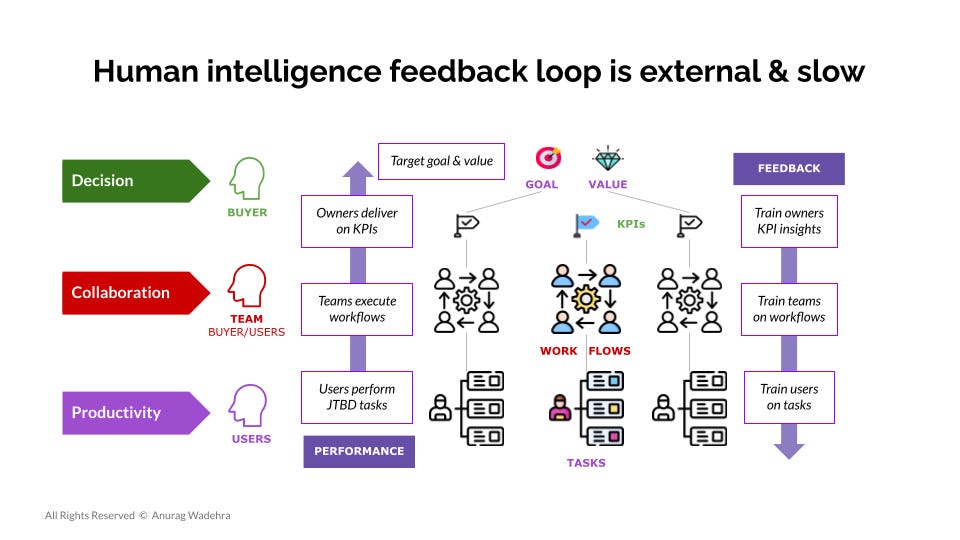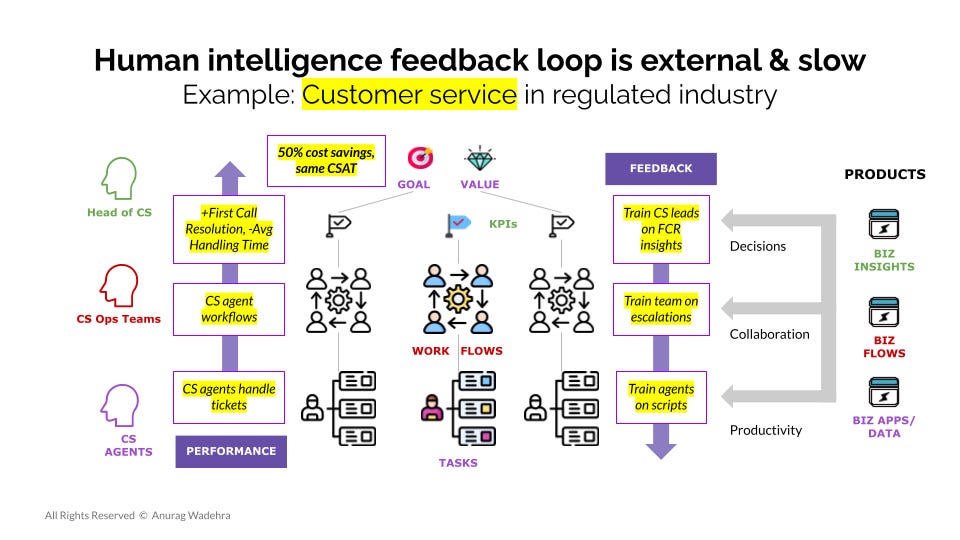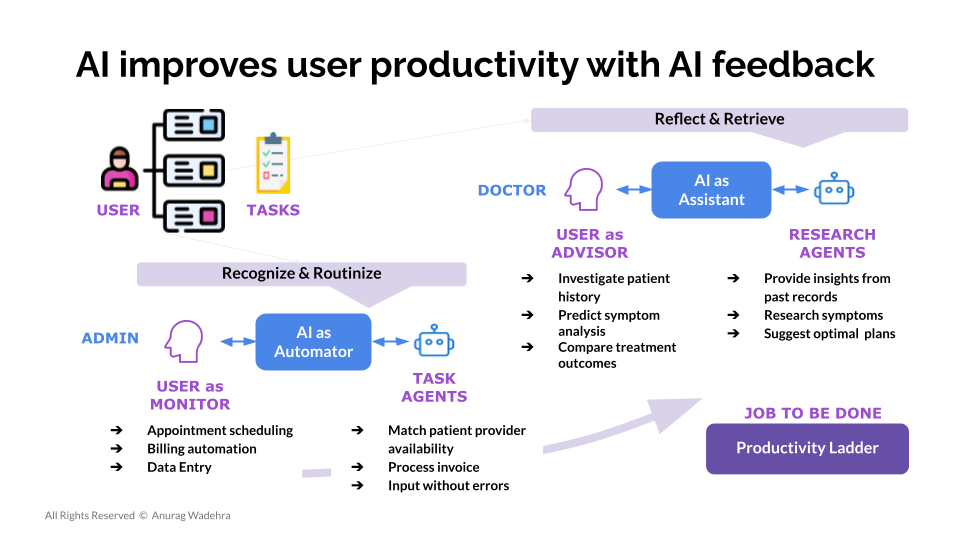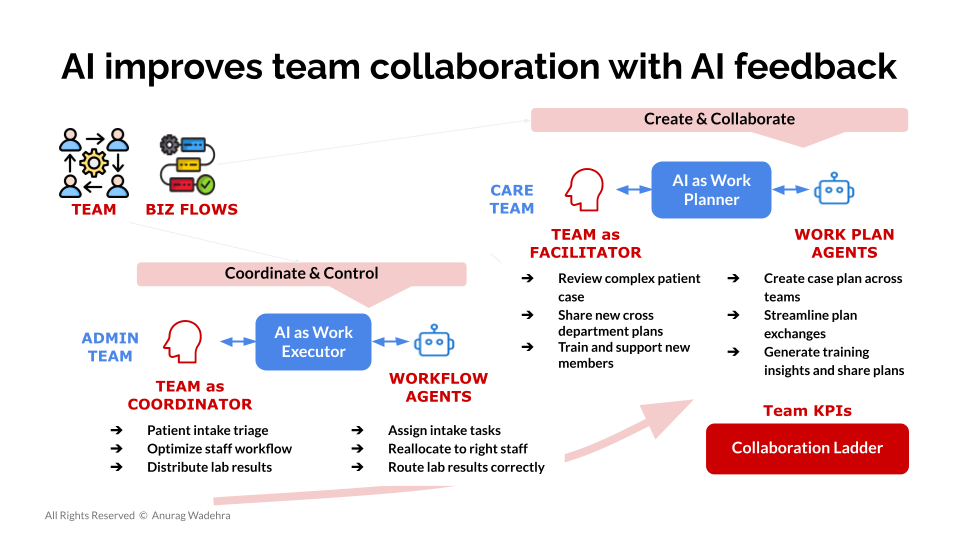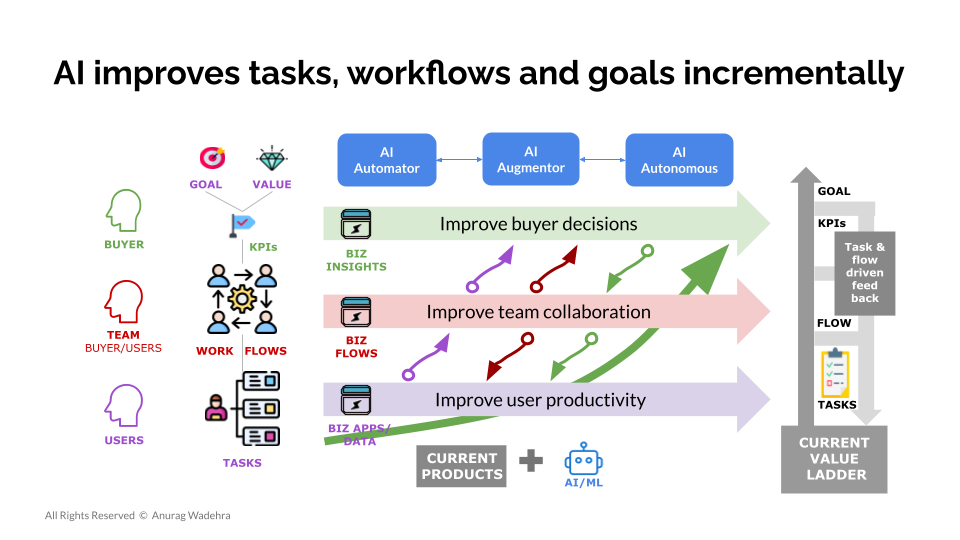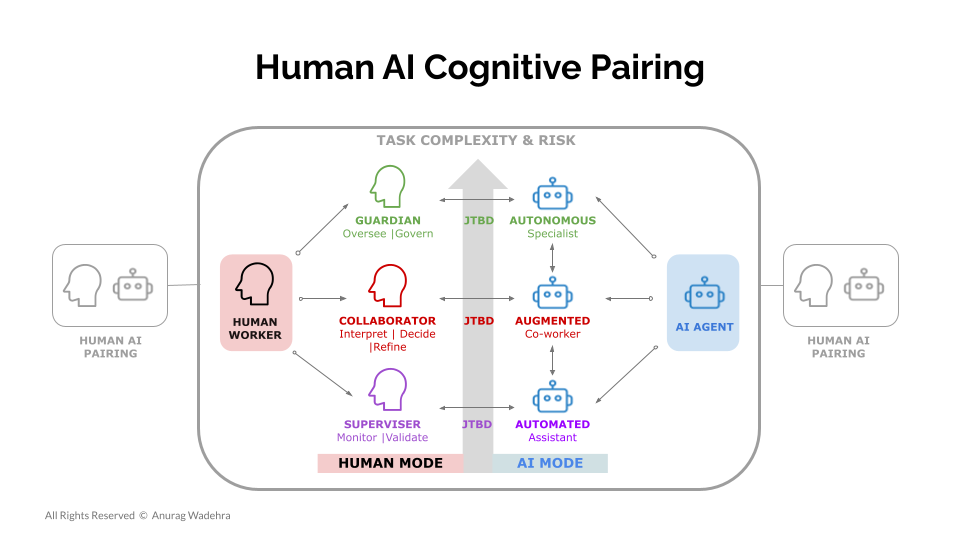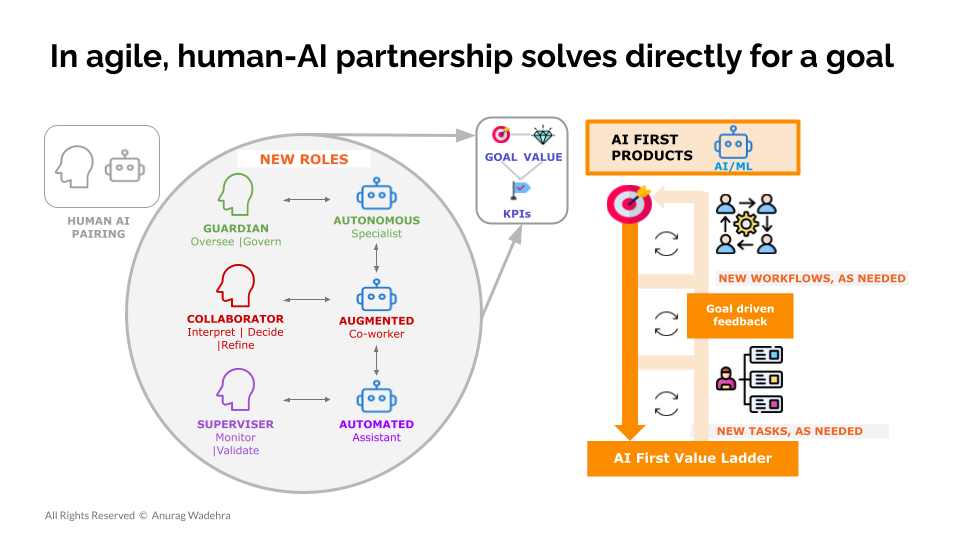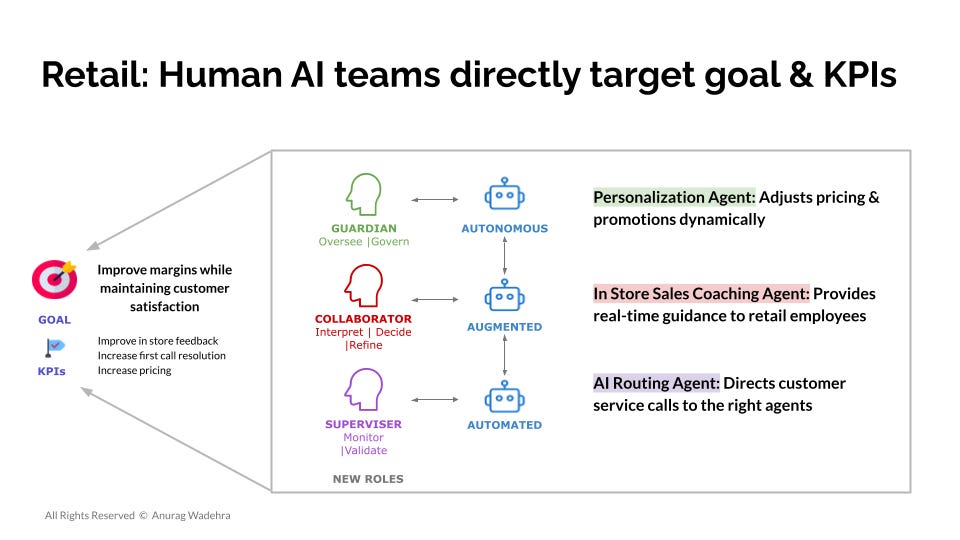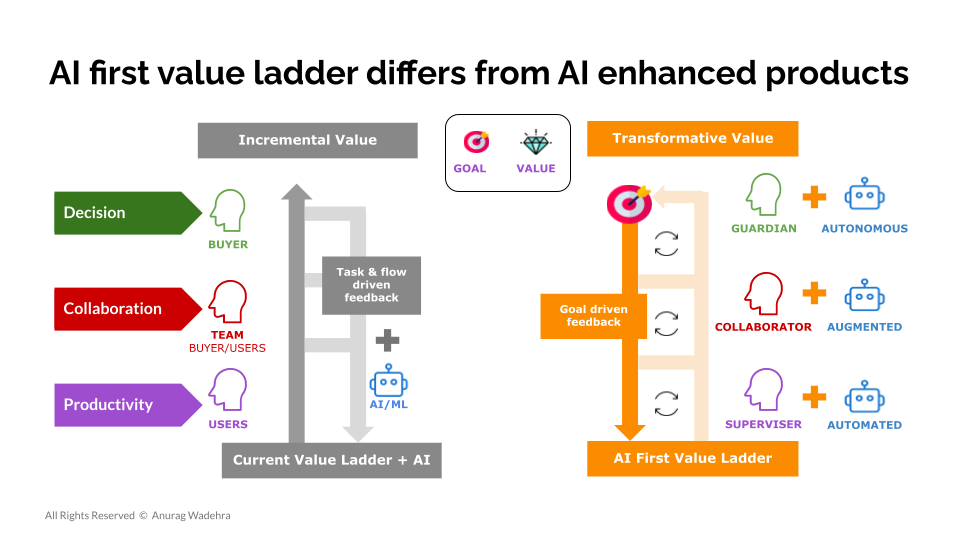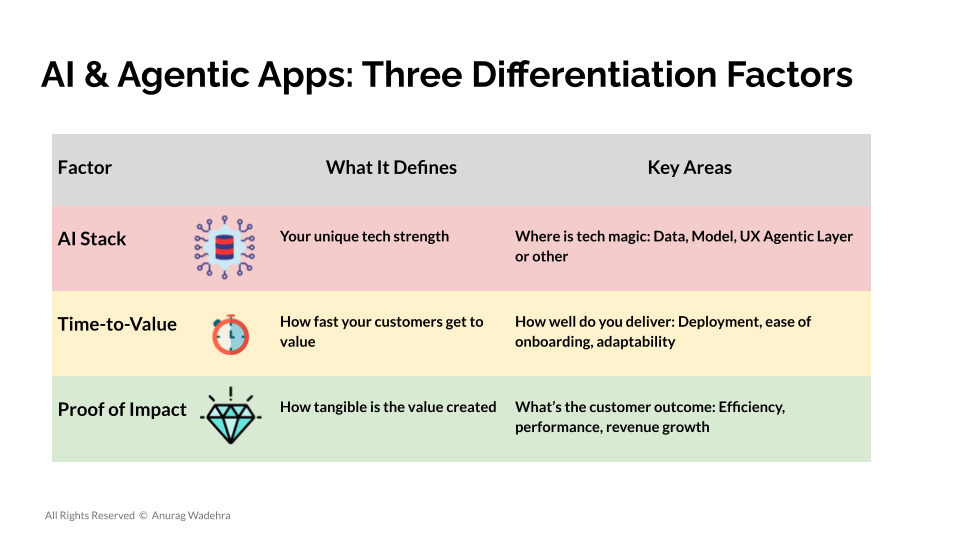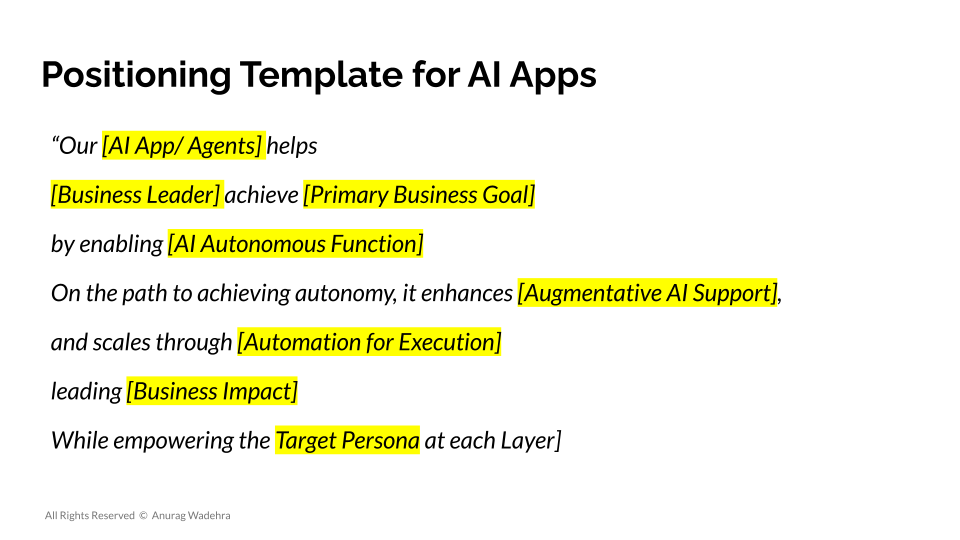Positioning Your AI & Agentic Apps to Win
A Short Guide
Introduction
The AI landscape is evolving rapidly, and to build a successful AI-powered product, it is crucial to position it effectively. In this blog post, I explain a structured approach that will help founders, product leaders, and GTM teams anchor their AI applications in real business value and differentiate them in a crowded market.
This post is an expanded version of a talk I gave recently on this topic. (video)
Setting the Stage: Why Positioning Matters
AI Is Not Enough
Many tech founders struggle to gain traction with their AI product for a simple reason they fail to appreciate.
AI is an ingredient technology whose value is in how it is applied, not how it is built.
The product teams and AI builders are in thrall of the latest models, benchmarks and architectures. They are busy educating the smart buyers on how to build a gen AI stack with RAG, how to engineer data pipelines, how to fine tune models, and how to deploy AI apps and wrappers.
Yet none of this matters much to positioning your AI product to win. Since this describes the how of AI, not what is the business value and why should buyers care for your specific AI-enabled products.
Your value proposition must be anchored in high-impact use cases and your AI capabilities should be differentiated by how they unlock this value within a business.
This guide provides a structured framework for positioning AI and agentic applications. It follows five critical steps. Whether you're developing an AI-first product or enhancing existing SaaS software with AI, these steps will help you craft a compelling value proposition and establish a winning market position.
How to Position AI & Agentic Apps for Market Success
To create a winning AI positioning, follow these structured steps:
Identify Your Industry Fit: Understand the AI adoption pattern of your industry: structured (e.g., healthcare) or agile (e.g., retail)?
Anchor on a Core AI Use Case: Choose a high-impact use case where AI delivers tangible benefits.
Determine the Role of AI Agents: Understand how AI agents fit alongside humans—Automator, Augmentor, or Autonomous.
Define Your AI Differentiation: Use the three-factor differentiation framework that includes value.
Position for Leadership: Craft a compelling positioning statement centred on a clear business value.
Understanding Structured vs. Agile AI Adoption
When it comes to AI adoption, industries can be classified as structured (e.g., healthcare, finance) or agile (e.g., tech, retail, media).
Structured industries
are regulated industries with strong legal, compliance and risk guardrails that are enforced by business users and teams and supported by established procedures and processes. They are likely to adopt AI gradually, starting with low level task automation and moving towards augmentation and autonomy, prioritizing compliance and risk management at every step, along with proven ROI. They also care a lot more about the impact of AI on human roles and jobs.
Agile industries
are more open to changing their people and processes due to competitive pressures. They are likely to integrate AI dynamically, focusing on immediate impact and differentiation through rapid experimentation and iteration. They may be more open to training employees to work with AI or reassigning them elsewhere within or outside the company.
In some cases this distinction may vary between companies within a sector. Or even within parts of a company. Nonetheless, understanding this distinction is a solid starting point to effective AI positioning. Why? Because AI adoption frameworks differ based on this distinction.
Structured Industries: The User-Team-Buyer Framework
Most SaaS product companies today follow this framework. Inside each company where their product is deployed, their users focus on tasks, teams collaborate on tasks through workflows that are internal or external to the app, and buyers focus on generating the overall business value by optimizing these tasks and flows through insights that are usually lagging.
This pattern of different personas (user/team/buyer) with different levels of accountability (productivity, collaboration, decisions) is common across thousands of SaaS applications. This framework has been stable for nearly two decades. The visual below shows how neatly each group does their part, and how the feedback flows over time to improve their work.
Here is the issue with the SaaS pattern:
Almost all the “intelligence” in apps today lies outside the application.
The true intelligence of humans - the feedback loop on their tasks, workflows and decisions - are mostly external to the app.
Hence these apps are slow and limited in how they improve - and ultimately how they deliver value.
Example:
If at a call center, the customer service agents are mishandling the support tickets, and CS ops teams have poor escalation processes, while the CS leaders don’t have correct dashboards to decide on fate of key service metrics, most of the remedies to inject “intelligence” in this situation are outside the app. Such as getting CS leaders the right insights to support decisions, improving the escalation protocols, and re-training human agents.
AI disrupts this twenty year SaaS pattern. By adding prescriptive, predictive, generative capabilities at each layer of the work. Let’s see how.
How to Layer AI into SaaS products:
Healthcare Example: AI-Assisted Patient Workflow Optimization
SaaS incumbents have a huge advantage here. They have an installed base of users and team workflows that already conform to current regulations and org hierarchies. People's hierarchies and processes change slower than AI tech. SaaS vendors may be able to layer in AI in their products, adding incremental value one layer at a time.
Consider the situation where a hospital is considering AI to optimize patient workflow.
User Layer:
AI improves task execution for hospital admin and doctors. This allows each of them to move up their personal productivity ladder.
In the initial stages, the software provider can help their Users recognize and routinize simple tasks using AI as Automator. The User’s role is that of a Monitor over such tasks, which may be executed through multiple task agents.
Over time, the software can help Users reflect and retrieve more intelligence to improve their personal productivity using AI as Assistant. Here the User’s role becomes that of an Advisor who is assisted by several research agents.
(examples in the picture)
Here are the three sharp questions to enhance user productivity with AI:
Who are the different user personas? And where is each of them in their productivity ladder?
What routine tasks can AI automate for each user?
What reflective tasks can AI assist for each user?
Team Layer:
AI coordinates workflows across care teams. This allows the teams to move up the collaboration ladder.
In the initial stages, the software provider can help the teams control and coordinate a few workflows with AI as Work Executor. The Team’s role is that of a Coordinator over such automated workflows, which may be executed through multiple workflow agents.
Over time, the software can help teams create and collaborate across workflows to plan more intelligence to improve collaboration outcomes using AI as Work Planner. Here the Team’s role becomes that of Facilitator who is assisted by several workplan agents.
(examples in the picture)
Here are the three sharp questions to enhance team collaboration with AI:
Who are the teams that use your software? And where is each of them in their collaboration ladder?
What routine workflows can AI execute for each team?
What collaborative workflows can AI plan for each team?
Buyer Layer:
AI optimizes resource allocation for hospital administrators. This allows the buyers to move up the decision ladder.
In the initial stages, the software provider can help the decision maker (buyer) predict and plan with AI as a decision support tool, such as a forecaster. The Buyer’s role is that of a Evaluator over such forecasts which may be executed through multiple predictive or forecasting agents.
Over time, the software can help the buyer - or the decision maker - make some decisions autonomously through AI that engages and operates systems to execute the decisions. Here the Buyer’s role is to guide and guard the autonomous agents in maintaining the decision quality and outcomes.
(examples in the picture)
Here are the three sharp questions to enhance buyer decision making with AI:
Who are the goals of the decision maker? What level of autonomy do they need on the decision?
What decisions can AI predict or forecast for the buyer?
What decisions can AI make autonomously for the buyer?
In summary, you can layer in AI into the current SaaS products for known users, teams and buyers in structured industries through progressive improvement of AI-led feedback at each of the three hierarchical layers. You can build direct AI and Agentic apps using this layered approach.
Note that the AI value ladder is bottom up, slowly driving to better outcomes of goals and KPIs - bringing along users, teams and buyers in roles they are already familiar with. This may be necessary for some industries and companies.
Agile Industries: Human AI Cognitive Pairing
AI is more disruptive than what we have been outlining so far. When we are not constrained by the hierarchical structures of current jobs and roles, we can reimagine how human workers may use AI and Agentic apps to achieve business goals.
This is happening in agile industries. At heart of this re-imagination is the idea of how humans and AI pair together. Of course, AI can and will displace humans from many tasks in a company. However, those remaining employees will work with AI at various levels of cognitive collaboration.
To understand this transformation, we must figure out different ways humans and AI can pair off to do cognitive work. This division of labor is at the heart of scaling - and positioning - AI inside a company.
There are many ways to categorize this. Here is one framework that maps humans in new roles (personas) alongside AI Agents personas.
Three ways human workers can pair with AI today, in a work environment.
Human as Supervisor; AI as an Automated Assistant
Focuses on routine task automation.
Eliminates repetitive, rule-based tasks.
Increases efficiency and reduces manual errors.
Example: AI-powered data entry and appointment scheduling in healthcare.
Human as Collaborator; AI as an Augmented Co-worker
Supports human decision-making with data-driven insights.
Enhances productivity without replacing human expertise.
Example: AI-assisted diagnostics that help doctors analyze patient records.
Human as Guardian; AI as Autonomous Specialist
AI Acts independently in decision-making
Executes complex, real time decisions
Guided and governed by experienced humans with right guardrails
Example: AI-driven forecasting tools that predict staffing needs in hospitals; AI-driven fraud detection in financial services.
Each of the three human personas depend on the tasks they are asked to perform based on their current task skills. The corresponding AI Agent personas depend upon the full stack capabilities, agentic and otherwise, imbued into these agents to support the human tasks. A human worker may shift from one persona to another as they master new skills to move up the complexity ladder or move down to take on new tasks - or pass a task to another human-AI pair.
In concert with this shift, the agents may learn from feedback and take on more tasks - while improving their core capability. And in turn, they may enroll or involve other agents, tools and resources as agentic platforms become ubiquitous.
This co-evolution of human-AI pairing is the driving force of the creative destruction - both creating new cognitive capacities for some humans at work while also relieving others from tasks no longer economically viable.
[As an aside, technically, there are more evolved & complex ways for Human and AI cognitive partnership that are possible today. I have limited this post to the three modes that are most common and practical today. Over time, The framework can be extended to incorporate more advanced pairing of Human as Mentor: AI as Learner and Human as Explorer: AI as Challenger. See my research note for more.]
In Agile, human AI partnership solves directly for a goal
This framework of cognitive coevolution explains how a small team of Human-AI pairs may be able to take on significant goals at work.
All the tasks are reconstituted among humans and agents to serve a goal, using this framework.
The UX and workflows are also redefined among humans and AI to serve the goal. And as KPIs improve through human-AI pairing, and as more value is realized, tasks and workflows keep getting reconstituted - all to serve the goal.
Example Retail: Improve margins while maintaining customer satisfaction
In this example, we can see how the overall goal is decomposed into smaller goals, which in turn, can be achieved through agile collaboration of human-AI agents, each team focusing on a narrower goal.
AI’s Value Ladder: Structured vs. Agile Environments
AI enhanced value ladder is incremental and bottom up, as it works through current hierarchies of roles, tasks and workflows.
Structured AI Value Ladder
(Healthcare, Finance, Manufacturing)
Bottom-Up Adoption: AI moves from automating tasks → enhancing workflows → enabling strategic decisions.
Example: AI in patient scheduling optimizes time slots → enhances care coordination → improves overall hospital efficiency.
This AI first value ladder is top-down and transformative with focus on goals and KPIs.
Agile AI Value Ladder
(Retail, Media, Consumer Tech)
Goal-Driven Adoption: AI is directly embedded in key decision-making.
Example: AI improves margin in retail by adjusting prices, routing service calls, coaching store agents.
Business Impact Framework
Here is a simple value framework: efficiency, effectiveness and scalability. The aim is to ensure that each AI & Agentic app can minimally show impact on key business metrics in one or more of these three areas. This framework is common across both approaches and can be used as a first pass.
The critical focus should be in attaching AI agents and apps directly to a key business metric.
Such a business metric can be tied to a task or use case - and can be anchored in a specific human-AI pairing.
Defining Your AI Differentiation
Now we come to the question of AI based differentiation. We went through the substantial pre-work on business context to get here because the differentiation of AI & Agentic applications is not only about technology—it must be framed in terms of business outcomes.
Three Key Differentiation Factors
This framework lays out a quick way to ensure your AI product is anchored in business value.
The three layers are:
AI Stack:
What makes your AI based capabilities unique? (Data, Model, UX, or Agentic Layer).
Rather than focus on a single part of the stack (data integration, or proprietary models or better UX), figure out the right combination of AI stack elements that makes your AI app or agents better than the alternative approaches. Often, the elements of your AI stack may not be highly distinct, but how you combine them to solve the key use cases may well be your differentiation.
Time-to-Value:
How quickly do customers see results? (Deployment speed, onboarding ease).
This is often overlooked in the hot world of AI demos and POCs. Customers are now skeptical of “cool” AI, so show a clear path to value with firm time commitments (deployment methodology, optimization and error corrections, governance etc.). All the factors that you will have to master to bring your AI app/agents to life in the hands of users with right guard rails.
Proof of Impact:
What are the measurable business outcomes? (Efficiency, revenue growth, customer success).
After you go live, you will need to show how your App is delivering measuring outcomes. Rather than wait for this, showcase these metrics before the sale, instrument them during the implementation, and use them operationally to prove the value of your AI and agentic apps. Ultimately, showcasing these metrics as part of the value framework above: efficiency gains (quantifiable cost savings), effectiveness (revenue improvements) or scalability of operations over time. .
Example: AI-Powered Patient Scheduling
AI Stack: AI app integrates with hospital data sources and embeds in current apps, learning from admin users.
Time-to-Value: Hospitals integrate it within 3 weeks.
Proof of Impact: 30% reduction in appointment no-shows.
In summary, a winning AI differentiation strategy must: showcase AI tech superiority (e.g., proprietary algorithms, better data models, faster processing); highlight rapid value realization (e.g., customers achieving measurable improvements within weeks of adoption); and provide tangible business benefits (e.g., quantifiable cost savings, revenue improvements, operational efficiency).
Creating a Winning AI Positioning Statement
Now, we can summarize all the above into positioning statements.
Guidelines for High-Impact Positioning
✅ Start with the highest business goal relevant to your industry (Autonomous AI).
✅ If full autonomy isn’t feasible, position your product as an Augmentor.
✅ If augmentation isn’t applicable, position your product as an Automator.
✅ Align AI capabilities with specific personas and their KPIs.
Positioning Template for AI App/Agents
Here is a simple way to summarize all the above.
Example: Healthcare AI Positioning Statement
“Our AI-powered Patient Flow Optimization Agent helps hospital executives maximize revenue and bed utilization by autonomously optimizing patient intake and discharge sequencing (Autonomous Layer). It augments hospital coordinators by predicting real-time patient demand (Augmentation Layer) and automates scheduling workflows (Automation Layer). This results in a 20% increase in capacity utilization and a 15% reduction in operational costs.”
Example: Retail AI Positioning Statement
“Our AI-powered Retail Demand Forecasting Agent helps retail executives maximize profitability by autonomously optimizing inventory levels and real-time pricing (Autonomous Layer). It augments inventory managers by providing predictive demand analytics (Augmentation Layer) and automates stock replenishment (Automation Layer), leading to a 12% revenue increase and 15% reduction in overstock waste.”
Key Takeaways
Positioning AI effectively requires a structured approach:
Identify Industry Fit – Understand how AI adoption varies across structured and agile industries.
Anchor on Core Use Cases – Ensure AI solves a real, high-value problem - incrementally or transformatively - based on your industry.
Define Human-AI Pairing – Clarify how AI serves as an Automator, Augmentor, or Autonomous agent to partner with humans.
Differentiate the AI Offering – Highlight unique AI stack, time-to-value, and proof of impact.
Establish Market Leadership – Craft compelling messaging and reinforce AI’s business impact.
By integrating these key insights, businesses can position AI solutions in a way that drives adoption, maximizes impact, and builds long-term market leadership.
References
Research Summary: AI-Human Collaboration in the Workplace
More in AI Value Series …



